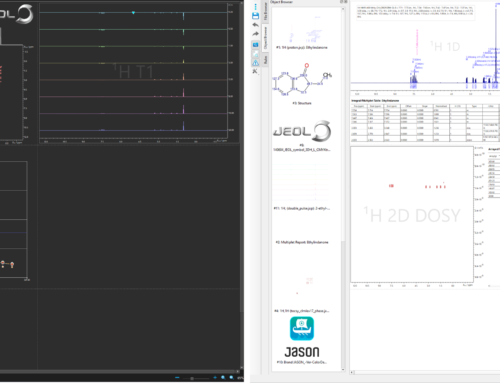Selective 1D experiments such as 1D NOESY and 1D TOCSY have grown in popularity in recent years, to the extent that they are now considered routine experiments for structure elucidation. However, while undeniably powerful, these experiments can be significantly compromised or even no use at all in instances where there is significant overlap between the peak to be selectively excited (“the target peak”) and other peaks in the spectrum. Chemical Shift Selective Filter (CSSF) experiments1 were specifically developed to overcome this limitation of conventional selective excitation experiments. In this post I’m going to outline the basic principles of CSSF and show some very useful features of the JASON software that help get the best CSSF spectra.
Chemical Shift Selective Filtering
The basic principle of CSSF is pretty easy to understand. The first step is to place the transmitter on-resonance with respect to the target peak. Then, a series of spectra is collected in which a time period t1 in the CSSF pulse sequence is gradually incremented. This variable period introduces a phase modulation of all the signals off-resonance with respect to the transmitter, but leaves the phase of target peak (and, critically, all its multiplet components) fixed. When the resulting spectra are co-added, the off-resonance signals cancel, leaving only the target peak. There are some experimental and pulse sequence details that I won’t go into here, but for a more detailed explanation of CSSF experiments, readers should take a look at the excellent paper by Robinson et al.1
The basic principle of CSSF is illustrated in Figure 1.

Figure 1. The CSSF principle. The CSSF experiment is repeated a number of times with an incremented period t1 that introduces offset-dependent phase modulation of the signals with respect to the transmitter frequency. Summing up the spectra from the experiments therefore cancels all but the target peak at the transmitter frequency
CSSF can be combined with mixing schemes such as NOESY and TOCSY to give highly-selective 1D versions of these experiments. To illustrate the power of the CSSF approach, Figure 2 shows a comparison of a conventional selective NOESY spectrum with a CSSF NOESY spectrum collected on a sample of 17β-estradiol. The data were collected on a JEOL ECZ500R spectrometer equipped with a ROYAL HFX probe using Delta software and processed using JASON v1.1 software. The conventional experiment is not selective enough to excite just the signal from 7β, giving a spectrum in which the NOE responses originate not just from 7β but from the overlapped signals 12β and 16α. In contrast, the high selectivity of the CSSF NOESY experiment allows 7β to be excited on its own, giving a spectrum with unambiguous NOE responses.

Figure 2. Comparison of conventional selective NOESY and CSSF NOESY collected on a sample of 17β-estradiol
Get better CSSF spectra with JASON
One of the complications with CSSF is that summing all of the collected experiments may not give optimum suppression of the off-resonance signals. This is in large part due to the sinc function excitation profile of the CSSF experiment, which gives alternating positive/negative regions of residual excited signal and “null points” (i.e. perfect suppression) away from the centre of the excitation band.

Figure 3. Typical sinc function excitation profile of CSSF experiment. The first null points are indicated with red arrows
It sounds somewhat counterintuitive but summing fewer experiments can give better suppression! This is because changing the number of summed experiments effectively changes the t1(max), which in turn alters the positions of the null points in the excitation profile. One of the really helpful features in JASON is the “CSSF processing” step that allows the user to specify how many experiments to use in the summation. Figure 4 shows a typical processing list for CSSF data that includes the “CSSF processing” step. The processing step also provides the user with estimates of the first and nth-order null points based on the number of experiments to include, which can be helpful when deciding how many experiments to include.
Figure 4. JASON processing list for CSSF data with the “CSSF processing” step
Another parameter that is included in the CSSF processing step is an exponential multiplier. T2 relaxation as the t1 period is incremented can affect the efficiency of the CSSF filter. To counter this, it can be helpful to multiply the experiments by a rising exponential and “fine tune” the filter. This is essentially the same as resolution enhancement by apodization functions in conventional 2D NMR processing. The CSSF processing is an alternative to 2D FT applied to the data shown in Fig. 1 and taking the sum projection of a narrow region around the centre of the indirect dimension.
Figure 5 shows a comparison of the CSSF-NOESY data of 17β-estradiol processed conventionally and processed using the dedicated CSSF tools in JASON. It was found by trial-and-error that using 13 of the 21 experiments and multiplying the spectra by a 6 Hz rising exponential gave optimum selectivity that is considerably better than is achievable using the conventional processing.

Figure 5. Comparison of conventional and JASON processing of CSSF data
To find out more about running CSSF experiments on JEOL instruments and processing CSSF data in JASON, let us know!
Reference
- P.T. Robinson, T. N. Pham, D. Uhrin, J. Magn. Reson., 2004, 170, 97-103.


